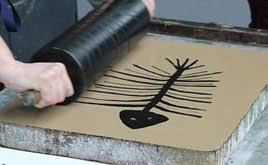What Is A Lithograph?
The word ‘’lithograph’’ is derived from two ancient Greek words: ‘’lithos’’ meaning ‘’stones’’ and ‘’graphien’’ meaning ‘’to write’’. Lithography works on a simple physical principal of immiscibility of water and grease/oil. This technique was first used around 1798. Limestone is the most common surface to work on. The image is drawn in reverse on the stone with greasy crayons. Afterwards, the stone is dampened with water, which is repelled by the greasy medium wherever the artist has drawn. Then the stone is inked with a massive roller loaded with oily ink which adheres to the greasy areas of the design, but is repelled by the wet areas of bare stone. The paper is then pressed to the stone and the ink is transferred to the paper. In a color lithograph, a different stone is used for each color. The stone must be re-inked every time the image is pressed to the paper. Most modern lithographs are signed and numbered to establish an edition.

Facts About Lithograph
- The word ‘’lithograph’’ is derived from two ancient Greek words: ‘’lithos’’ meaning ‘’stones’’ and ‘’graphien’’ meaning ‘’to write’’.
- Lithograph is an antiquated printmaking process using flat stones or metal plates.
- A lithographic image is created by drawing an image directly onto a flat printing surface using materials like oil-based inks, litho crayons or specialized greasy pencils etc.
- Lithograph is based on the simple principle of immiscibility of water and grease/oil.
- Original Lithographs typically have the signature of the artist on them.
- Lithograph print leaves the rows and dots or irregular marks in their printing. If hands make it, then it will have ink dots in it.
- Types of lithograph include: Original stone lithograph, original plate lithograph, lithographic reproduction, offset print, Mylar plate lithograph etc.
- Lithograph is relatively slow as it takes time to print text and images.
- A lithograph print is more affordable and still carries a tag of exclusivity and quality.
- Does not produce many copies when compared to printing.
What Is A Print ?
A print is a work of graphic art which has been conceived by the artist to be realized as an original work of art, rather than a copy of a work in another medium. Prints are produced by drawing or carving an image onto a hard surface (known as a matrix) such as a wood block, metal plate or stone. This surface is then inked and the image is transferred to paper or another material by the application of pressure, thus creating an impression or print. The printed image that results is the exact reverse of the image on the plate. Unlike paintings or drawings, prints usually exist in multiple impressions, each of which has been created from the same inked plate.

Facts About Print
- The word ‘’Print’’ meaning A mark or character made by impression is derived from French word preinte meaning ‘’pressed’’.
- A print is work of graphic art which has been produced by a process which enables it to be multiplied. In other words, a print is any pictorial image of which more than one copy exists.
- Prints are typically done by mechanical devices.
- Printing method involves transferring ink from a printing plate to whatever is being printed.
- Print documents will not have a signature on them.
- The print does not leave any ink dots or irregular marks as it is done by machines.
- Types of prints include: Digital printing, screen printing, 3D printing, flexography, Gravure etc
- Print is relatively fast, as it takes relatively less time to produce text and images.
- A print is relatively expensive.
- Produces relatively many copies.
Also Read: Difference Between Lithograph And Print
Difference Between Lithograph And Print In Tabular Form
| BASIS OF COMPARISON | LITHOGRAPH | |
| Etymology | The word ‘’lithograph’’ is derived from two ancient Greek words: ‘’lithos’’ meaning ‘’stones’’ and ‘’graphien’’ meaning ‘’to write’’. | The word ‘’Print’’ meaning A mark or character made by impression is derived from French word preinte meaning ‘’pressed’’. |
| Description | Lithograph is an antiquated printmaking process using flat stones or metal plates. | A print is any pictorial image of which more than one copy exists. |
| Creation | A lithographic image is created by drawing an image directly onto a flat printing surface using materials like oil-based inks, litho crayons or specialized greasy pencils etc. | Prints are typically done by mechanical devices. |
| Signature | Original Lithographs typically have the signature of the artist on them. | Print documents will not have a signature on them. |
| Working Principle | Lithograph is based on the simple principle of immiscibility of water and grease/oil. | Printing method involves transferring ink from a printing plate to whatever is being printed. |
| Irregular Print | Lithograph print leaves the rows and dots or irregular marks in their printing. If hands make it, then it will have ink dots in it. | The print does not leave any ink dots or irregular marks as it is done by machines. |
| Types | Original stone lithograph, original plate lithograph, lithographic reproduction, offset print, Mylar plate lithograph etc. | Digital printing, screen printing, 3D printing, flexography etc |
| Printing Speed | Lithograph is relatively slow as it takes time to print text and images. | Print is relatively fast, as it takes relatively less time to produce text and images. |
| Affordability | A lithograph print is more affordable and still carries a tag of exclusivity and quality. | A print is relatively expensive. |
| Number Of Copies | Does not produce many copies when compared to printing. | Produces relatively many copies. |